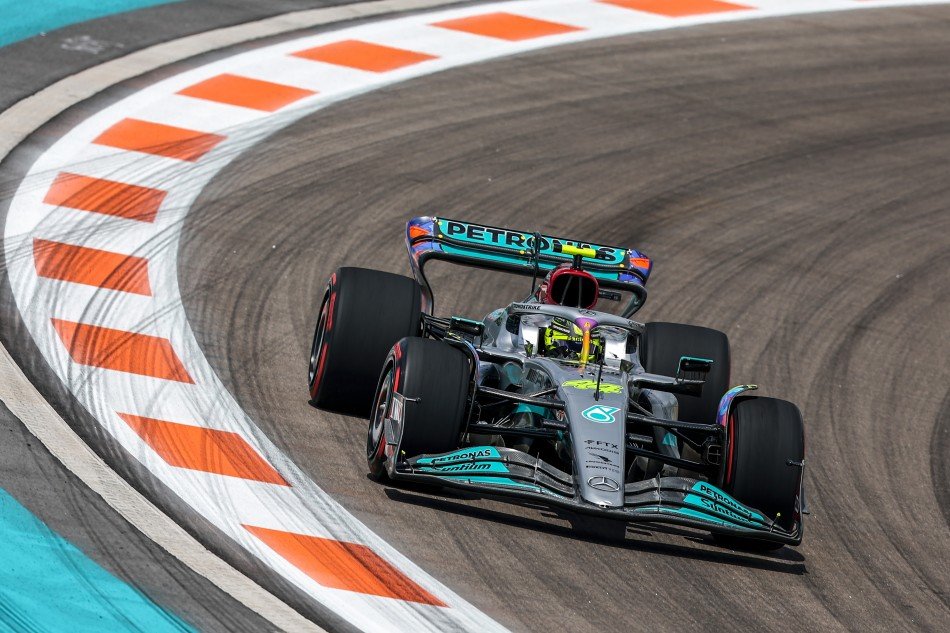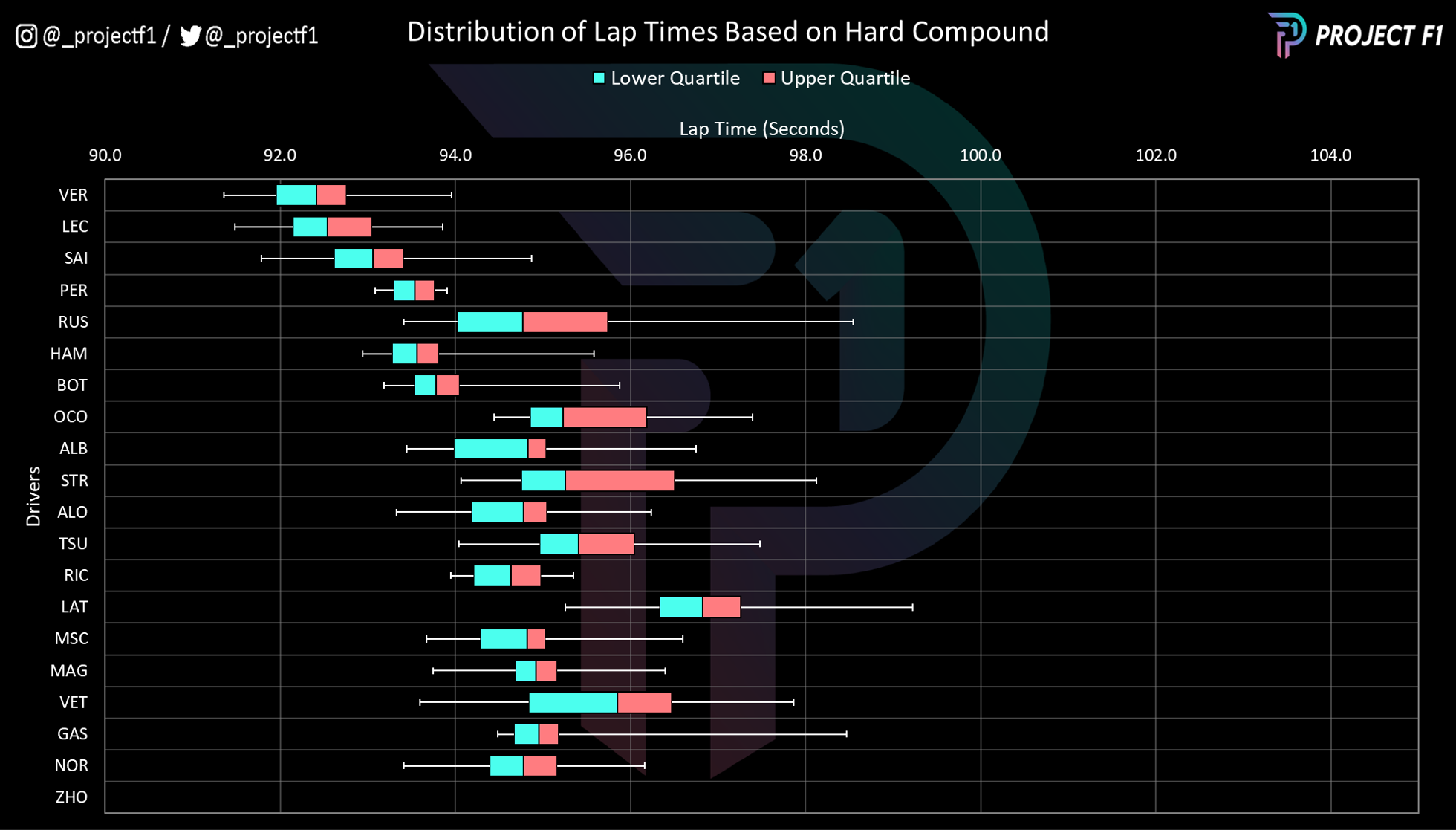Midfield Comes ALive in Miami - Miami 2022
Formula 1 returns to the United States for the inaugural Miami Grand Prix. The new track, with its combination of long straights and technical sections, proved a challenge for both drivers and engineers alike, as teams grappled with trying to find the optimal setup and strategy for the hot and intense race. And while the contest at the front had its time in the sun, there was plenty going on down the rest of the midfield to keep intrigued and anticipation running. Let’s jump straight into it.
Sometimes Good Fortune and No Mistakes Trump Race Pace
Chart 1: Cumulative Delta Plot
As usual, the cumulative delta plot (as shown above in Chart 1) captures the key dynamics and storylines from this weekend’s race. The chart highlights the divergent performances of many in the midfield, with some drivers having a stellar first stint on the medium tyre while others struggled. For some others, it was about taking the alternate strategy of going long on the hard tyre and switching to a softer compound later in the race to recoup for mistakes prior to the race. While for some it was a matter of keeping it clean and consistent while avoiding any melees that are common on a street circuit.
We start by taking a look at the race between the Alfa Romeo of Valtteri Bottas and the two Mercedes’ of George Russell and Lewis Hamilton. Bottas was hot out of the gates, helping him make the most of an impressive qualifying that saw him start the race in P5. Bottas is able to keep his old teammate, Hamilton, at bay for the first half of the first stint before stretching the lead at lap 19 as shown in Chart 1 above. Not only was Bottas able to stay competitive against the faster Mercedes, but he was able to extend the stint demonstrating that he had superior tyre wear as well. What is most impressive is how he was able to keep extracting more pace despite the compound wearing down more and more.
Chart 2: Lap Times Compared - Bottas vs Mercedes
But this was a tale of two halves, with Hamilton coming back at Bottas during the second stint on the hard tyre. Another important callout from Chart 1 is how Bottas wasn’t able to make a meaningful dent into the gap to Russell despite the Briton being on an old set of hard tyres. Instead, Russell was continuing to post better and better lap times as shown in Chart 2. Better yet, the lap times were on par if not better than those of Bottas on the fresher compound. This comes down to the tyre performing better as you wear through the gauge as well as the benefit of fuel burn - as can be seen through the profile of Esteban Ocon, Lance Stroll and Sebastian Vettel.
Be that as it may, Russell would still need to stop at some point (unless he was wishing to do a repeat of Alexander Albon’s final lap pitstop from Australia). But fate would have it that Russell wouldn’t need to do anything so dire as a tangle of confusion between Lando Norris and Pierre Gasly would then bring out the safety car - allowing the Briton a cheap pitstop and track position against his peers. No doubt, Russell was a benefactor of good fortune, but he still needed to do a good enough job in tyre management to be able to capitalise on such a situation. From here, Russell was in a prime position to mount a challenge against Bottas and also Hamilton.
Chart 3: Bottas Makes a Mistake
The tight contest between the three drivers resumed after the safety car restart. But Bottas was in a tricky situation given Russell had the benefit of the slipstream, DRS and fresh tyres. The Finn could hold the fort initially due to being close enough to Perez to nullify some of the slipstream advantage. But the pace differential of the Red Bull would mean this would be short-lived. On lap 49, Bottas has a moment on the exit of turn 17 whereby he struggles to slow the car enough and runs deep. Bottas has to come off the throttle and collect the car to avoid the wall and in turn, completely compromises his run down to the short start-finish straight. This is more than enough of an opportunity for both Hamilton and Russell - who were hot on his heels - to breeze on through. With the Alfa Romeo seeming to lack on the hard tyre, there wasn’t much more that Bottas could do to salvage the situation. In the end, P7 was a good finish - but short of delivering a perfect P5.
Keeping it clean and avoiding DRS trains go a long way.
Further down the field, it was more a story of good strategy execution and making sure to not get caught up in any incidents. Return to Chart 1 and the other major callout is the large and long-lasting DRS train - headed by Fernando Alonso and reared by an unfortunate Lando Norris. However, Norris’ misfortune was twofold. The first came from the odd decision to pit on lap 18 given there were no issues in his pace and the little margin to the traffic behind. The second came from a slightly slow stop that voided any margin for error in the strategy. The net effect of these two things is that Norris fell to the back of the DRS train and he wasn’t able to make any progress as those in front were able to generate better performance by working through the tyre gauge - as observed with George Russell prior. Even though Norris’ race ended by way of contact with Gasly, his race was virtually over after being stuck in the DRS train for more than 20 laps.
Daniel Ricciardo’s strategy was not much better. While the McLaren pitwall may have learned from the dangers of pitting into a DRS train, Ricciardo was then left in no man’s land. Despite having decent pace and longevity on the medium tyre, he was falling into the clutches of Ocon on the hard. With no safety car thus far, it was potentially risky to wait too long. As such, the Australian pitted and carried on only to come to the misfortune of a safety car which handed the advantage to his competitors ahead.
Charts 4 and 5: Race Pace Distributions
So while McLaren was a good example of how to not do strategy in Miami, Alpine and Aston Martin showed how to make the best of a bad situation. With both Aston Martin drivers starting from the pitlane due to a fuel issue and Ocon starting from the back of the grid due to a chassis change, the use of the alternate strategy was a no brainer. All three drivers, while materially slower than the medium tyre runners initially, were all able to work through and transition into a long and competitive stint. The Aston’s were able to hold off the Haas drivers despite the American team sporting the fresher rubber after a set of early pitstops. This is apparent in the race pace distributions in charts 4 and 5 above. This lasted for several laps until the grip levels became inconsistent and mistakes started to occur. In any case, the safety car not only served as a reset for this contest but also afforded Ocon and the Aston drivers the chance for a cheap pitstop - as well as the benefit of softer tyres with lower fuel loads.
But the racing got a bit rough and scruffy, with multiple incidents between the rest of the midfield. The most notable of these was the tangle between Mick Schumacher and Sebastian Vettel that took both drivers out of the points-paying positions. Others included an excursion from Lance Stroll and some naughty driving that would land both Magnussen and Ricciardo time penalties. All of this commotion alongside Alonso’s earlier penalties brought Stroll into the points and elevated Albon’s finishing position to P9 - an impressive result for the Williams driver. While Albon’s race was rather anonymous, he kept his head down to stay within reach and was there to pick up the pieces when others fell apart.
WatchPoints for the Next Grand Prix
We’re back to Europe for the next couple of races with Barcelona taking centre stage. Unlike Miami, it is a track that is well known to the team personnel and drivers alike. The circuit is also a departure from the high-speed nature of the season so far, featuring more downforce dependent and technical sections. The race weekend should serve as an interesting experiment to see whether the Red Bull package is one that can deliver in these circumstances - or if its prowess is confined to power dependent and low drag dependent tracks. The return to Europe should also serve as an opportunity for the introduction of some upgrades and take the development race to the next step. I’ll see you in the next instalment!







